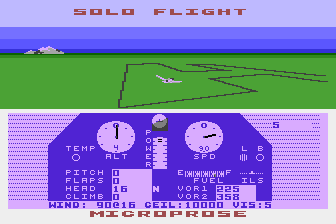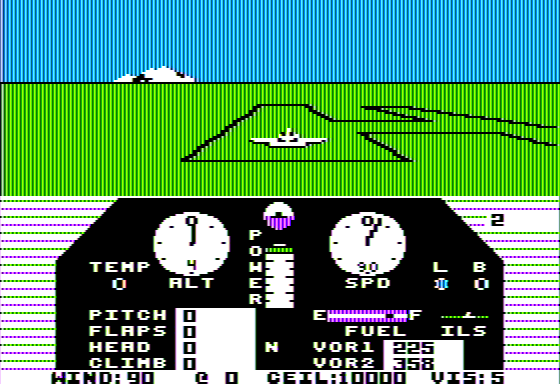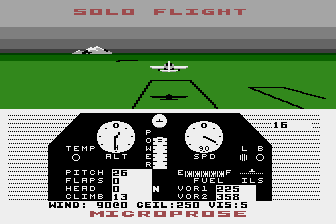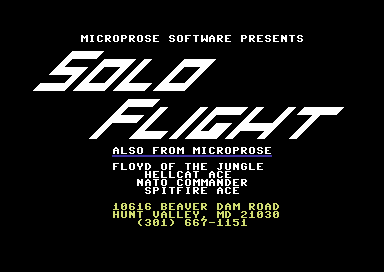Retro Replay Review
Gameplay
Solo Flight delivers a deeply rewarding simulation experience by putting you in the cockpit of a mail plane tasked with completing runs across Kansas, Colorado and Washington (with the bonus option of venturing into Oregon). From the moment you plan your first flight, the game demands thoughtful consideration: how much fuel will you need to reach your destination with enough reserves to handle unexpected detours? Every decision—from payload weight to route selection—directly impacts your success and final score.
(HEY YOU!! We hope you enjoy! We try not to run ads. So basically, this is a very expensive hobby running this site. Please consider joining us for updates, forums, and more. Network w/ us to make some cash or friends while retro gaming, and you can win some free retro games for posting. Okay, carry on 👍)
Advanced avionics features such as VOR tower readings, DME (Distance Measuring Equipment) and ILS (Instrument Landing System) bring an authentic layer of complexity. If you choose clear weather, you can enjoy visual navigation and scenic vistas; but step into light or heavy cloud cover and you’ll rely almost entirely on instruments. Precision plotting on paper maps becomes a must, as a well-planned VOR-to-VOR flight can line you up perfectly for that final ILS descent.
The scoring system further enriches the experience by rewarding efficient fuel management, payload decisions and successful deliveries. Carrying multiple mail loads increases your potential points but also affects your aircraft’s handling, fuel burn and climb rate. This tension between risk and reward keeps each flight engaging, challenging you to refine your techniques and push your piloting skills even in total cloud blindness.
Graphics
Although Solo Flight’s visuals are modest by modern standards, they serve the simulation perfectly. The cockpit view presents clear, easy-to-read instrument dials for airspeed, altitude, heading, and vertical speed. VOR needles and glide slope indicators are crisp and intuitive, making instrument-only flying a satisfying puzzle rather than an exercise in frustration.
The external view, when used, provides simple but effective outlines of terrain, runways and horizon lines. Daytime flights offer gentle color palettes for fields and mountains, while night flying becomes a minimalist affair of runway lights against a dark sky. Even with basic graphics, you quickly learn to interpret what you see and trust your instruments over your eyes.
Weather effects—ranging from clear skies to dense cloud layers—are conveyed through smooth transitions and appropriate cockpit instrument shading. While there’s no high-definition terrain or texture detail, the graphical style enhances immersion by focusing on the essential elements a pilot needs. In this sense, Solo Flight’s graphics aren’t flashy but are highly functional and supportive of the core simulation.
Story
Solo Flight doesn’t offer a cinematic narrative or cutscenes; instead, it weaves its story through your mail delivery missions. Each flight is presented as a real postal run, complete with different originating and destination airports, varying cargo weights and evolving weather conditions. This open-ended structure allows you to craft your own pilot’s tale with every leg you fly.
The sense of progression emerges naturally: starting with shorter, straightforward hops in Kansas, you build confidence before tackling long-distance routes over Colorado’s mountains or Washington’s rugged terrain. Success leads to heavier payloads, riskier weather forecasts and the ever-present challenge of IFR flights in heavy clouds. Your personal narrative grows from these small victories and setbacks.
While there are no defined characters or plot twists, Solo Flight captures the enduring romance of bush flying and the discipline of instrument navigation. You become the protagonist, confronting unpredictable weather, mechanical considerations and the satisfaction of delivering mail on time. That emergent storytelling, born from mechanics rather than scripted dialogue, is the heart of its appeal.
Overall Experience
Solo Flight is best suited for simulation enthusiasts and aspiring virtual pilots who relish planning and precision. The learning curve can be steep—especially when relying on VOR/DME navigation and executing ILS approaches in total cloud cover—but the reward of a perfectly flown flight is immense. If you enjoy mapping out every leg on paper charts and mastering your cockpit instruments, this title will hold your attention for hours.
The game’s minimalist presentation and focus on core flight dynamics create a timeless experience. Whether you’re tackling dawn mail runs in Kansas or nighttime IFR approaches in Washington, you’ll find that careful preparation and steady hands at the yoke are your keys to success. Even decades after its release, Solo Flight remains a compelling study in aeronautical discipline.
In the end, Solo Flight stands as a testament to the power of thoughtful simulation design. It strips away needless complexity and centers on the pure satisfaction of navigating by instruments, balancing fuel and payload, and touching down safely on each runway. For anyone seeking an authentic mail-pilot adventure, this is one flight you won’t want to miss.
 Retro Replay Retro Replay gaming reviews, news, emulation, geek stuff and more!
Retro Replay Retro Replay gaming reviews, news, emulation, geek stuff and more!









Reviews
There are no reviews yet.